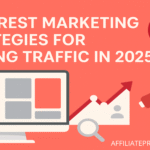Welcome to my article “The Ultimate Guide to SEO for Affiliate Marketers”.
You have dipped your toes into affiliate marketing, dreaming of passive income flowing in while you sip coffee in your pajamas. Sounds idyllic, right? But then you realize that without traffic, your affiliate links are like party invitations no one opened. Enter SEO—your ticket to organic traffic, higher rankings, and, ultimately, more clicks on those affiliate links. Spoiler alert: it’s not rocket science, but it does take a bit of finesse.
In this ultimate guide, we’ll break down everything you need to know about leveraging SEO to turbocharge your affiliate marketing game. From mastering keyword research to crafting content that converts, and even snagging those all-important backlinks, we’ve got you covered. And don’t worry—we’ll keep it practical, actionable, and throw in a few jokes to keep things light (because nothing’s worse than a dry SEO guide, am I right?). By the end, you’ll be equipped with all the tools you need to rank higher, earn more, and maybe even get that coffee upgrade. Let’s dive in!
My Best Recommended & Proven Way to Make $100-$300 Daily – Watch This FREE Video to START >>>

Understanding the Basics of SEO for Affiliate Marketing
If affiliate marketing is the engine that drives your income dreams, SEO is the fuel that keeps it running smoothly. Without it, your fantastic product reviews and listicles might as well be written in invisible ink. So, let’s demystify the basics of SEO and why it’s your BFF in the affiliate marketing game.
At its core, Search Engine Optimization (SEO) is like a matchmaking service between your content and search engines. You create the content (your dazzling “Top 10 Camping Gadgets” post), and SEO helps Google decide if it’s good enough to introduce to its users. Do it right, and you’ll rank higher, bringing hordes of organic traffic to your site. Do it wrong, and, well, your blog ends up in search engine purgatory, hanging out with keywords no one searches for.
SEO has three main pillars: On-Page SEO, Off-Page SEO, and Technical SEO. Think of them as the holy trinity of ranking success.
- On-Page SEO: This is the art of making your content irresistible to search engines. It’s about choosing the right keywords, crafting click-worthy titles, and writing content that makes readers (and algorithms) go, “Wow, this is exactly what I needed!”
- Off-Page SEO: This one’s all about your content’s popularity contest. It involves earning high-quality backlinks from other sites, getting shout-outs on social media, and convincing the internet that your blog is the prom queen of affiliate marketing.
- Technical SEO: The nerdy but essential sibling of the bunch. This includes site speed, mobile-friendliness, and ensuring Google can crawl your site without getting lost in a digital labyrinth.
For affiliate marketers, SEO isn’t just an option—it’s a lifeline. Organic traffic often converts better than any paid campaign because the audience is already searching for what you’re offering. Plus, who doesn’t love free traffic? Mastering SEO basics means your content gets in front of the right people at the right time, which, in the affiliate world, translates to more clicks, more conversions, and—cue the confetti—more commission.
Remember, SEO isn’t magic, but when done right, it sure can feel like it. So grab your metaphorical magnifying glass, and let’s uncover the secrets to making your affiliate content shine in the search engine spotlight.
Conducting Keyword Research for Affiliate Content
Let’s face it: jumping into affiliate marketing without proper keyword research is like trying to sell snow cones in Antarctica—completely misplaced and destined to flop. Keywords are the backbone of your SEO strategy, helping you tap into what your audience is actually searching for online. Get them right, and you’ll be raking in clicks and commissions. Get them wrong, and you might as well be shouting into the void.
Why Keyword Research Matters
Imagine this: a potential customer is frantically Googling “best noise-canceling headphones for studying.” Now, if you’ve targeted the right keyword (spoiler alert: that one’s gold), your meticulously crafted affiliate content will pop up like a hero with a cape. But if you’ve focused on something vague like “headphones,” you’re competing with tech giants and every blog on the planet. The result? Your page is buried on Google’s page 12—also known as the digital graveyard.
For affiliate marketers, the key is to prioritize buyer-intent keywords. These are the search terms people use when they’re ready to whip out their credit cards. Think:
- “Best X for Y” (e.g., “best laptops for video editing under $1,000”).
- “Product reviews” (e.g., “iPhone 15 vs. Samsung Galaxy S23 review”).
- “Where to buy” (e.g., “where to buy affordable gym equipment online”).
These keywords not only attract traffic but also bring in an audience that’s primed to convert.
How to Find Affiliate-Friendly Keywords
Gone are the days of guessing what people might type into Google. Today, we have powerful tools that make keyword research a breeze:
- Google Keyword Planner: A great free option for brainstorming keyword ideas.
- Ubersuggest: A beginner-friendly tool for finding long-tail keywords.
- SEMrush or Ahrefs: Advanced (and paid) tools for deeper keyword insights like search volume and competition levels.
- Answer the Public: Perfect for finding questions people are asking about your niche.
My Best Recommended & Proven Way to Make $100-$300 Daily – Watch This FREE Video to START >>>
Steps to Conduct Keyword Research
- Start Broad, Then Narrow Down: Begin with broad terms related to your niche. For instance, if you’re promoting fitness gear, start with “workout equipment.” Then drill down to more specific terms like “adjustable dumbbells for beginners.”
- Focus on Low-Competition Keywords: High-volume keywords are tempting, but they’re also incredibly competitive. Instead, target long-tail keywords like “best adjustable dumbbells for small spaces,” which are easier to rank for and often attract buyers with specific needs.
- Analyze Search Intent: Not all clicks are created equal. Make sure the keywords you choose align with the intent of your content. Someone searching “how to use resistance bands” probably wants a tutorial, while “buy resistance bands online” screams buyer intent.
Pro Tips for Affiliate Keyword Research
- Look at Your Competitors: Tools like Ahrefs let you spy on the keywords your competitors rank for. If it works for them, it can work for you, too.
- Think Seasonally: Keywords like “best Christmas gifts for fitness enthusiasts” can bring a traffic surge during the holidays.
- Don’t Forget Voice Search: With smart assistants on the rise, target conversational phrases like “what’s the best way to lose weight fast?”
Putting Keywords to Work
Once you’ve nailed down your keywords, it’s time to weave them naturally into your content. Use them in your title, meta description, headings, and throughout your article—but don’t overdo it. Keyword stuffing is like adding too much salt to a recipe; it ruins the flavor and gets you penalized by Google.
Remember, keyword research isn’t a one-time thing. Trends shift, new products emerge, and search behaviors evolve. Stay on top of it, and you’ll have a steady stream of organic traffic heading straight to your affiliate links. And when that traffic converts into sales? Well, let’s just say, you’ll be glad you took the time to pick the right keywords.
Creating High-Converting, SEO-Optimized Affiliate Content
Let’s cut to the chase: in the wild world of affiliate marketing, content is king—but not just any content. We’re talking about content so compelling, informative, and SEO-friendly that it makes readers click your affiliate links faster than they click “Skip Ads” on YouTube. Crafting high-converting, SEO-optimized affiliate content is both an art and a science, and when you nail it, the rewards are sweeter than that first sip of morning coffee.
Step 1: Pick the Right Content Format
Not all affiliate content is created equal. To convert readers into buyers, you need to give them the exact type of information they’re searching for. Here are a few proven formats:
- Product Reviews: Share detailed, honest reviews of individual products. Include pros, cons, and personal anecdotes if possible.
- Comparison Posts: Think “Product A vs. Product B”—perfect for readers deciding between two options.
- Listicles: Everyone loves a good “Top 10” post. Highlight the best products in a category and explain why they made the cut.
- Tutorials: Show readers how to use a product, solve a problem, or achieve a goal using your affiliate product.
- Buyer’s Guides: Help readers make informed decisions with detailed guides like “How to Choose the Best Laptop for Students.”
Pro Tip: Match the content format to the reader’s intent. Someone searching for “best cameras under $500” wants a listicle, not a step-by-step photography guide.
Step 2: Optimize for SEO Without Sounding Like a Robot
SEO optimization is crucial, but let’s be clear—no one wants to read a keyword-stuffed mess that sounds like it was written by a spam bot. Here’s how to strike the right balance:
- Use Keywords Strategically: Sprinkle your target keyword in the title, meta description, headings, and a few times in the body text. Bonus points if you can include it in the first 100 words.
- Write for Humans First, Algorithms Second: Your goal is to help readers, not just rank on Google. Answer their questions, solve their problems, and make the content engaging.
- Optimize for Featured Snippets: Many users don’t even click through to the top result; they grab the snippet info. Structure your content to answer direct questions (e.g., “What is the best laptop for gaming?”) in a concise paragraph.
Step 3: Add Elements That Drive Conversions
SEO brings traffic, but good content seals the deal. Make sure your affiliate posts are optimized for conversions:
- Clear Call-to-Actions (CTAs): Don’t leave readers guessing. Use phrases like “Check the latest price on Amazon” or “Get 10% off here.”
- High-Quality Images: If you’re promoting a product, show it off! Include sharp, appealing images to enhance trust and engagement.
- Buttons and Links: Make your affiliate links stand out with attractive buttons like “Buy Now” or “Learn More.” But don’t overdo it—no one likes a link-filled circus.
- Social Proof: If a product has rave reviews or testimonials, share them. Social proof helps build trust and pushes readers toward a purchase.
Step 4: Prioritize User Experience (UX)
No matter how great your content is, a poor user experience can drive readers away faster than a pop-up ad invasion. Here’s how to keep them hooked:
- Make It Scannable: Use short paragraphs, bullet points, and subheadings. Most people skim before committing to reading.
- Load Times Matter: If your site takes more than a few seconds to load, your visitors (and Google) will bounce.
- Mobile Optimization: With so many users browsing on their phones, your site needs to look just as good on a small screen as it does on a desktop.
Step 5: Inject E-A-T Into Your Content
Google loves content that demonstrates Expertise, Authoritativeness, and Trustworthiness (E-A-T). For affiliate marketers, this means:
- Expertise: Show you know your stuff. Include personal experience or well-researched data to back up your claims.
- Authoritativeness: Reference credible sources. For example, if you’re recommending fitness gear, link to a reputable health organization or study.
- Trustworthiness: Be honest. If a product has flaws, mention them. Readers appreciate transparency and are more likely to trust your recommendations.
Step 6: Don’t Forget Internal and External Links
Linking is SEO gold, but it also enhances the reader’s journey:
- Internal Links: Guide readers to other relevant posts on your site, like “Our Top 5 Fitness Gadgets” linking to “How to Use Fitness Trackers Effectively.”
- External Links: Cite authoritative sources to build trust and give your readers extra value.
Building Backlinks and Improving Domain Authority
Backlinks—the lifeblood of SEO and the golden tickets to higher rankings. If your affiliate marketing content is the party, backlinks are the cool kids showing up and telling everyone else, “Hey, this is where it’s at!” But backlinks aren’t just about popularity; they’re about trust, authority, and proving to Google that your content is worth putting on the first page. Let’s dive into why backlinks matter and how you can earn them without resorting to spammy, black-hat tactics.
Why Backlinks Are Essential for Affiliate Marketers
In SEO, backlinks are like digital endorsements. When another website links to your content, it’s essentially saying, “We trust this source.” Google takes note and uses these links as a signal of your site’s authority and relevance. The more high-quality backlinks you have, the more likely you are to rank higher in search results.
For affiliate marketers, this is a game-changer. Higher rankings mean more organic traffic, which means more eyeballs on your affiliate links and—drumroll, please—more commission. But here’s the catch: not all backlinks are created equal. A link from a reputable site like Forbes is worth a hundred spammy links from low-quality sites. Quality > Quantity, every time.
My Best Recommended & Proven Way to Make $100-$300 Daily – Watch This FREE Video to START >>>
How to Build Backlinks the Right Way
- Create Link-Worthy Content
- The easiest way to earn backlinks is to produce content so good, people can’t help but share it. Think:
- Comprehensive guides (like this one!).
- Original research or data studies.
- Infographics that simplify complex topics.
- Pro Tip: Focus on creating evergreen content that stays relevant over time. A well-written buyer’s guide or comparison article can attract backlinks for years.
- The easiest way to earn backlinks is to produce content so good, people can’t help but share it. Think:
- Guest Blogging Done Right
- Guest blogging is like networking for your website. Reach out to blogs in your niche and offer to write a high-quality article in exchange for a backlink to your site.
- But beware! Choose sites that are relevant to your niche and have decent domain authority (DA). Writing for low-quality sites won’t help your rankings and might even hurt them.
- Build Resource Links
- Many websites maintain resource pages with helpful links on specific topics. If you’ve created a valuable guide or resource, reach out and suggest they include your content.
- The Skyscraper Technique
- Identify popular content in your niche, create something even better, and then reach out to the sites linking to the original piece. Essentially, you’re saying, “Hey, I noticed you linked to this article. Mine offers even more value—how about linking to it instead?”
- Collaborate with Influencers
- Influencers in your niche often have websites or blogs. Partnering with them for collaborations, reviews, or co-written posts can earn you valuable backlinks while expanding your reach.
Avoid Spammy Link-Building Tactics
Let’s talk about the dark side of backlinking for a second. Buying links or joining sketchy “link farms” might seem like a shortcut, but it’s a surefire way to get slapped with a Google penalty. Here’s what to steer clear of:
- Automated link-building tools.
- Irrelevant or low-quality sites.
- Excessive reciprocal linking (i.e., “I link to you, you link to me”).
Google’s algorithm is smart—like, scary smart. If your backlink profile looks unnatural, you’re more likely to drop in rankings than rise.
Improving Your Domain Authority (DA)
While backlinks are a big piece of the puzzle, domain authority is a broader metric that reflects your site’s overall SEO health. Improving your DA takes time, but it’s worth the effort. Here’s how to boost it:
- Focus on Content Quality: Consistently publish high-quality, relevant content that solves your audience’s problems.
- Enhance Technical SEO: Ensure your site is fast, mobile-friendly, and free of broken links or other errors.
- Build a Strong Internal Linking Structure: Link to your own content strategically to keep readers engaged and distribute link equity across your site.
- Earn Social Signals: While not a direct ranking factor, content that gets shared on social media can attract backlinks and traffic.
Track Your Backlink Progress
What’s the point of all this effort if you’re not tracking your progress? Use tools like Ahrefs, SEMrush, or Moz to monitor your backlinks and domain authority. These platforms show you who’s linking to you, the quality of those links, and even opportunities to reclaim broken or lost links.
Monitoring and Improving SEO Performance
If SEO were a sports game, monitoring your performance would be the instant replay that shows you exactly what’s working—and what’s flopping harder than a bad infomercial. For affiliate marketers, tracking and improving SEO performance isn’t just a nice-to-have; it’s the secret sauce for staying competitive in a world where everyone is vying for those coveted first-page spots. The good news? With the right tools and strategies, you can take the guesswork out of SEO and turn your affiliate site into a traffic magnet.
Step 1: Know What Metrics Matter
Before you dive into analytics, it’s crucial to know what you’re looking for. Otherwise, you’ll drown in data faster than you can say “bounce rate.” Here are the key metrics every affiliate marketer should track:
- Organic Traffic: The bread and butter of SEO. Keep an eye on how much of your traffic comes from search engines versus other sources.
- Keyword Rankings: Are you climbing the ranks for your target keywords, or are they stuck on page 57?
- Click-Through Rate (CTR): If your pages show up in search results but no one clicks, your titles or meta descriptions might need a makeover.
- Bounce Rate: High bounce rates could mean your content isn’t meeting visitors’ expectations—or your site takes longer to load than an old dial-up modem.
- Backlink Profile: Track the number and quality of backlinks pointing to your site. Are they growing steadily or stagnating?
- Conversion Rate: Ultimately, it’s all about those clicks on your affiliate links. Monitor how many visitors are converting into buyers.
Step 2: Use the Right Tools for the Job
SEO without tools is like trying to fix a car with your bare hands—technically possible, but unnecessarily painful. Here are some must-haves for monitoring your performance:
- Google Analytics: The go-to tool for tracking traffic, user behavior, and conversions. Bonus: It’s free!
- Google Search Console: Perfect for monitoring keyword rankings, indexing issues, and click-through rates.
- Ahrefs or SEMrush: Paid tools that give you a deep dive into keyword rankings, backlinks, and competitor analysis.
- PageSpeed Insights: Check how fast your site loads and get actionable tips to speed it up.
- Rank Math or Yoast (WordPress Plugins): These plugins provide on-page SEO recommendations and track basic performance metrics.
Step 3: Diagnose Problems Like an SEO Detective
Sometimes, even your best content doesn’t rank. Before you panic, put on your detective hat and dig into the data:
- Dropped Rankings: Did your page rank well initially but lose traction? Check for algorithm updates, new competitors, or outdated content.
- High Bounce Rates: Analyze whether your content matches the searcher’s intent. For example, if someone searches “best hiking shoes,” they’re not looking for your life story—they want recommendations fast.
- Low Backlink Growth: If your backlinks have plateaued, it might be time to ramp up outreach or revisit your content strategy.
Step 4: Improve What’s Underperforming
Now that you’ve identified what needs fixing, it’s time to roll up your sleeves and get to work:
- Refresh Old Content: Dust off your older posts and update them with fresh information, better visuals, or additional products. Google loves content that stays relevant.
- Optimize for New Keywords: If your content isn’t ranking for your original keywords, pivot! Use tools like Ubersuggest to identify new, lower-competition keywords.
- Revamp CTAs: If traffic is high but conversions are low, your affiliate links or call-to-actions might need a facelift. Make them clear, enticing, and hard to ignore.
- Improve Internal Linking: Guide readers through your site by linking to related content. This not only helps with SEO but also keeps visitors engaged longer.
Step 5: Stay Ahead of the Curve
SEO is a moving target. What worked last year (or last month) might not cut it anymore. To stay ahead:
- Keep Up with Algorithm Updates: Follow SEO news from reliable sources like Moz, Search Engine Journal, or Google’s official blog.
- Spy on Competitors: Use tools like SEMrush to see what keywords they’re ranking for and how their backlink profiles are evolving.
- Experiment and Adapt: SEO is part science, part art. Don’t be afraid to try new strategies, test different content formats, or explore emerging platforms like voice search optimization.
Step 6: Track, Tweak, Repeat
SEO isn’t a one-and-done deal; it’s an ongoing cycle. Regularly check your metrics, make adjustments, and monitor how those changes impact your performance. Think of it like gardening: you plant the seeds (content), water them (promote and optimize), and prune what’s not growing (remove or improve underperforming pages).
Conclusion
Congratulations, you made it to the finish line! If you’ve been following along, you now have a solid game plan for taking your affiliate marketing SEO strategy from “meh” to magnificent. Whether you’re a complete newbie or a seasoned pro looking to up your game, the key takeaway here is simple: SEO is your best friend in the affiliate world—and like any good friendship, it requires consistent effort, a little TLC, and the occasional check-in to make sure everything’s on track.
We’ve covered everything from the basics of SEO and keyword research to crafting killer content, building backlinks, and monitoring performance like a hawk. It may seem like a lot, but here’s the beauty of it: each piece of the puzzle works together to create something far greater than the sum of its parts. Start small. Pick one area—maybe keyword research or improving old content—and build from there. Rome wasn’t built in a day, and neither is a top-ranking affiliate site.
One Last Pep Talk
Let’s be real: SEO can feel overwhelming. Algorithms change, competition is fierce, and sometimes you just want to throw your laptop out the window when your traffic dips for no apparent reason. But here’s the thing: every effort you put into improving your SEO is an investment in the long-term success of your affiliate business. It’s not about quick wins or overnight success; it’s about creating a strong, sustainable foundation that pays off month after month, year after year.
Now, Go Forth and Dominate
The digital world is your oyster, and with the strategies you’ve learned here, you’re armed with the tools to shuck it wide open. So go on, tackle those keywords, fine-tune your content, and charm those backlinks into existence. Remember, the journey to SEO success is more like a Netflix binge than a blockbuster movie—slow, steady, and oddly satisfying.
My Best Recommended & Proven Way to Make $100-$300 Daily – Watch This FREE Video to START >>>
And who knows? With enough dedication, your affiliate site could become the next go-to resource in your niche, driving traffic, clicks, and commissions while you kick back and enjoy the fruits of your labor. Or at least a well-earned coffee break.
You’ve got this. Now go crush it!
Thank you for reading my article “The Ultimate Guide to SEO for Affiliate Marketers” till the end. Hope it helped you. See you with another article.










